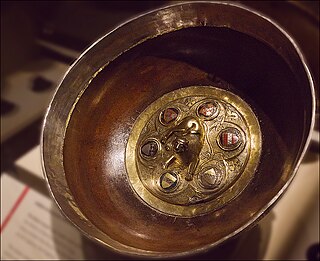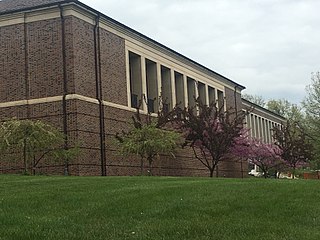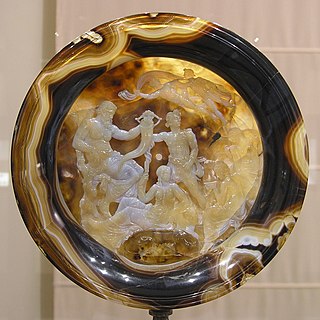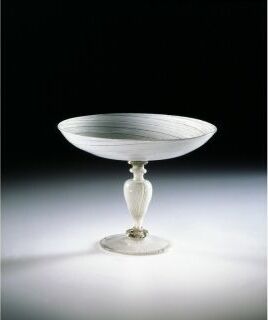
The Centennial International Exhibition of 1876, the first official World's Fair to be held in the United States, was held in Philadelphia, Pennsylvania, from May 10 to November 10, 1876, to celebrate the 100th anniversary of the signing of the Declaration of Independence in Philadelphia. Officially named the International Exhibition of Arts, Manufactures, and Products of the Soil and Mine, it was held in Fairmount Park along the Schuylkill River on fairgrounds designed by Herman J. Schwarzmann. Nearly 10 million visitors attended the exposition, and 37 countries participated in it.

Johann Jakob Scheuchzer was a Swiss scholar born at Zürich.

Cameo is a method of carving an object such as an engraved gem, item of jewellery or vessel. It nearly always features a raised (positive) relief image; contrast with intaglio, which has a negative image. Originally, and still in discussing historical work, cameo only referred to works where the relief image was of a contrasting colour to the background; this was achieved by carefully carving a piece of material with a flat plane where two contrasting colours met, removing all the first colour except for the image to leave a contrasting background.

Malachite is a copper carbonate hydroxide mineral, with the formula Cu2CO3(OH)2. This opaque, green-banded mineral crystallizes in the monoclinic crystal system, and most often forms botryoidal, fibrous, or stalagmitic masses, in fractures and deep, underground spaces, where the water table and hydrothermal fluids provide the means for chemical precipitation. Individual crystals are rare, but occur as slender to acicular prisms. Pseudomorphs after more tabular or blocky azurite crystals also occur.

Christopher Newport University (CNU) is a public liberal arts university in Newport News, Virginia. CNU is the youngest comprehensive university in the commonwealth of Virginia. The institution is named after Christopher Newport, who was a buccaneer and captain of Susan Constant, the largest of three ships which carried settlers for the Virginia Company in 1607, on their way to found Jamestown in the Virginia Colony, which became the first permanent English settlement in North America.

The Baths of Diocletian were public baths in ancient Rome, in what is now Italy. Named after emperor Diocletian and built from 298 AD to 306 AD, they were the largest of the imperial baths. The project was originally commissioned by Maximian upon his return to Rome in the autumn of 298 and was continued after his and Diocletian's abdication under Constantius, father of Constantine.

The Richard Nixon Presidential Library and Museum is the presidential library and burial site of Richard Milhous Nixon, the 37th President of the United States (1969–1974), and his wife Pat Nixon.

Tableware are the dishes or dishware used for setting a table, serving food and dining. It includes cutlery, glassware, serving dishes and other items for practical as well as decorative purposes. The quality, nature, variety and number of objects varies according to culture, religion, number of diners, cuisine and occasion. For example, Middle Eastern, Indian or Polynesian food culture and cuisine sometimes limits tableware to serving dishes, using bread or leaves as individual plates. Cups are not dishes. Special occasions are usually reflected in higher quality tableware.

Asa Packer was an American businessman who pioneered railroad construction, was active in Pennsylvania politics, and founded Lehigh University. He was a conservative and religious man who reflected the image of the typical Connecticut Yankee. He served two terms in the United States House of Representatives (1853–1857).

A mazer is a special type of wooden drinking vessel, a wide cup or shallow bowl without handles, with a broad flat foot and a knob or boss in the centre of the inside, known technically as the print or boss. They vary from simple pieces all in wood to those ornamented with metalwork, often in silver or silver-gilt. They use dense impervious woods such as maple, beech and walnut wood, and get their name from the spotted or birdseye marking on the wood, or possibly maserle as a name for Acer campestre. They are a north European medieval tradition, mostly made from the 11th to the 16th centuries.

The Linda Hall Library is a privately endowed American library of science, engineering and technology located in Kansas City, Missouri, sitting "majestically on a 14-acre (5.7 ha) urban arboretum." It is the "largest independently funded public library of science, engineering and technology in North America" and "among the largest science libraries in the world."
William Andrews Nesfield (1793–1881) was an English landscape architect and artist.

Linda is the site of an old ghost town in the Linda Valley in the West Coast Range of Tasmania, Australia. It has also been known as Linda Valley.

Saint-Porchaire ware is the earliest very high quality French pottery. It is white lead-glazed earthenware often conflated with true faience, that was made for a restricted French clientele from perhaps the 1520s to the 1550s. Only about seventy pieces of this ware survive, all of them well known before World War II. None have turned up in the last half-century. It is characterized by the use of inlays of clay in a different coloured clay, and, as Victorian revivalists found, is extremely difficult to make.

The Farnese Cup or Tazza Farnese is a 2nd-century BC cameo hardstone carving bowl or cup made in Hellenistic Egypt in four-layered sardonyx agate, now in the Naples National Archaeological Museum It is a 20 cm wide and similar in form to a Greek phiale or Roman patera, with no foot. It features relief carvings on both its exterior and interior surfaces and is around twenty centimeters in diameter.

The Welsh traditional costume was worn by rural women in Wales. It was identified as being different from that worn by the rural women of England by many of the English visitors who toured Wales during the late 18th and early 19th centuries. It is very likely that what they wore was a survival of a pan-European costume worn by working rural women. This included a version of the gown, originally worn by the gentry in the 17th and 18th centuries, an item of clothing that survived in Wales for longer than elsewhere in Britain. The unique Welsh hat, which first made its appearance in the 1830s, was used as an icon of Wales from the 1840s.

The Royal Gold Cup or Saint Agnes Cup is a solid gold covered cup lavishly decorated with enamel and pearls. It was made for the French royal family at the end of the 14th century, and later belonged to several English monarchs before spending nearly 300 years in Spain. It has been in the British Museum since 1892, where it is normally on display in Room 40, and is generally agreed to be the outstanding surviving example of late medieval French plate. It has been described as "the one surviving royal magnificence of the International Gothic age". According to Thomas Hoving, former director of the Metropolitan Museum of Art in New York, "of all the princely jewels and gold that have come down to us, this is the most spectacular—and that includes the great royal treasures."

Doucai is a technique in painted Chinese porcelain, where parts of the design, and some outlines of the rest, are painted in underglaze blue, and the piece is then glazed and fired. The rest of the design is then added in overglaze enamels of different colours and the piece fired again at a lower temperature of about 850°C to 900°C.

The Aldobrandini Tazze are a set of 12 silver-gilt standing cups in the shallow tazza shape, sometimes described as bowls or dishes. They are outstanding examples of Renaissance metalwork, described by John Hayward as "the most impressive single monument of Italian and perhaps European goldsmith's work of the 16th century", and by the Victoria and Albert Museum as "one of the most spectacular groups of 16th century silver to survive".



















